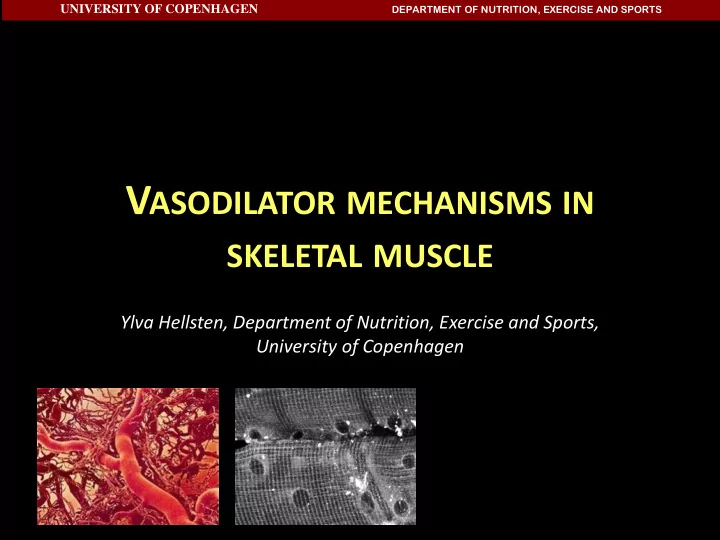

UNIVERSITY OF COPENHAGEN DEPARTMENT OF NUTRITION, EXERCISE AND SPORTS V ASODILATOR MECHANISMS IN SKELETAL MUSCLE Ylva Hellsten, Department of Nutrition, Exercise and Sports, University of Copenhagen
UNIVERSITY OF COPENHAGEN DEPARTMENT OF NUTRITION, EXERCISE AND SPORTS S KELETAL MUSCLE BLOOD FLOW C HARACTERISTICS - WIDE RANGE OF FLOWS - PRECISE MATCHING OF FLOW TO OXYGEN DEMAND - RAPID RISE WITH ONSET OF EXERCISE Leg blood flow WITHOUT A FALL IN BLOOD PRESSURE 0.2-0.4 l/min 7-10 l/min Rådegran & Saltin 1998 Saltin et al. 1998
UNIVERSITY OF COPENHAGEN DEPARTMENT OF NUTRITION, EXERCISE AND SPORTS Tight coupling between flow and muscle metabolism- but how does the muscle know how much oxygen it needs? How is muscle blood flow regulated? What do we know about mechanisms?
UNIVERSITY OF COPENHAGEN DEPARTMENT OF NUTRITION, EXERCISE AND SPORTS Overall regulation of skeletal muscle blood flow + Smooth muscle cells integrate the - constrictive and dilatory signals Vasodilators Functional Sympathetic activity Sympatholysis Vasoconstrictors What happens with sympathetic activity during exercise?
UNIVERSITY OF COPENHAGEN DEPARTMENT OF NUTRITION, EXERCISE AND SPORTS K EY P OINT To achieve an increase in flow during exercise , vasodilators must be formed locally in the active muscle to an extent that well overcomes the vasoconstrictive effect of the increased sympathetic activity
UNIVERSITY OF COPENHAGEN DEPARTMENT OF NUTRITION, EXERCISE AND SPORTS Cellular sources of vasodilators in skeletal muscle Skeletal muscle cells Endothelial cells Smooth muscle cells A RTERIOLE C APILLARY Erythrocytes
UNIVERSITY OF COPENHAGEN DEPARTMENT OF NUTRITION, EXERCISE AND SPORTS Which vasodilators are formed in the muscle? Skeletal muscle Endothelial cells cells ATP ATP Nitric oxide Nitric oxide Prostacyclin Adenosine A RTERIOLE C APILLARY Erythrocytes ATP Nitric oxide
UNIVERSITY OF COPENHAGEN DEPARTMENT OF NUTRITION, EXERCISE AND SPORTS K EY P OINT Nitric oxide and prostacyclin are central vasodilators in skeletal muscle
Mechanisms which lead to the formation of vasodilators Skeletal muscle Shear stress contraction Oxygen desaturation Conducted/ of the retrograde hemoglobin vasodilation molecule Coupling to oxygen need
E NDOTHELIAL DEPENDENT AND INDEPENDENT VASODILATION Endothelial cells Smooth muscle Endothelial cells independent Erythrocyte Endothelial dependent
Mechanisms of vasodilation M ECHANICALLY MEDIATED MECHANOTRANSDUCTION - SHEAR STRESS SHEAR STRESS VEGFR2 PECAM-1 Glycocalyx ERK 1/2 MAPK PKA Endothelial cell Vasodilation NO Prostaglandins
UNIVERSITY OF COPENHAGEN DEPARTMENT OF NUTRITION, EXERCISE AND SPORTS Mechanisms of vasodilation E RYTHROCYTE M EDIATED V ASODILATION O 2 O 2 NO ATP Sympatholysis P2Y Endothelial cell NO PGs Vasodilation
Mechanisms of vasodilation Conducted or retrograde vasodilation: How vasodilation can be conveyed from the site of capillaries and arterioles upstream ? ATP Fast electromechanical signalling Bagher & Segal Acta Physiol. 2011 and slow calcium waves convey vasodilation upstream
UNIVERSITY OF COPENHAGEN DEPARTMENT OF NUTRITION, EXERCISE AND SPORTS Physiological role of vasodilators: Change in exercise flow in response to arterial infusion of inhibitors of vasodilator systems eNOS → Nitric oxide Reduced L-NMMA exercise COX → Prostacyclin hyperemia? Indomethacin Endothelial cell INFUSION Femoral artery OF INHIBITOR
UNIVERSITY OF COPENHAGEN DEPARTMENT OF NUTRITION, EXERCISE AND SPORTS P HARMACOLOGICAL INHIBITION OF NO AND PG FORMATION : E FFECT ON EXERCISE I NDUCED V ASODILATION Vascular conductance 30 (ml/min/ mmHg) 25 Control 20 NOS+ COX 15 Blockade 10 5 0 Rest 60 90 240 Time (s)
UNIVERSITY OF COPENHAGEN DEPARTMENT OF NUTRITION, EXERCISE AND SPORTS P HARMACOLOGICAL INHIBITION OF E ITHER NO OR PG FORMATION : E FFECT ON EXERCISE I NDUCED V ASODILATION Vascular conductance (ml/min/ mmHg) 30 25 Control NOS Block 20 COX Block 15 10 5 0 Rest 60 90 240 Time (s) V ASODILATOR REDUNDANCY : One vasodilator system compensates for the reduced function of another
K EY P OINT Interaction between vasodilator systems is an important feauture in muscle blood flow control
UNIVERSITY OF COPENHAGEN DEPARTMENT OF NUTRITION, EXERCISE AND SPORTS Vascular function-vasodilator capacity: Vasodilation in response to arterial infusion of vasodilators Nitric oxide Epoprostenol (PGI 2 ) NO ATP Vasodilation R Prostaglandins Ado EDHF Ach Endothelial cell INFUSION Femoral artery OF COMPOUND
UNIVERSITY OF COPENHAGEN DEPARTMENT OF NUTRITION, EXERCISE AND SPORTS Type II diabetics have reduced vasodilator respons to infusion of ATP and adenosine Leg blood flow (L/Min) in relation to infused conc ATP and 4 adeno nosin sine Control 3 T2D * 2 * 1 0 Baseline ATP Adenosine Baseline ATP Adenosine Thaning et al. 2010 ; 2011
UNIVERSITY OF COPENHAGEN DEPARTMENT OF NUTRITION, EXERCISE AND SPORTS C OPENHAGEN W OMEN S TUDY Prosta stacycli lin Pre and post menopausal women Pre Post The effect of 3 months of intense cycle Menopause Menopause training on the responsiveness to prostacyclin 49+/ _ 1 yrs 53+/ _ 1 yrs Age 23+/ _ 0.5 23+/ _ 0.6 BMI Pre training comparison Change with training
UNIVERSITY OF COPENHAGEN DEPARTMENT OF NUTRITION, EXERCISE AND SPORTS Several vasodilator mechanisms allow for rapid and precise adjustment according to oxygen demand and for coordination of flow Several vasodilators interact and allow for optimal regulation and compensatory mechanisms (Redundancy) Nitric oxide and prostaglandins are two central vasodilators Oxygen is highly likely to be key in the precise control of blood flow in relation to metabolic demand
Recommend
More recommend